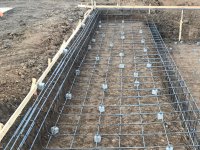Hello,
I am in the under construction phase and have found lots of really helpful information on this site so thank you!
My question which I have not seen posted by anyone else is my rebar is touching the wood framing in a large number of places. In others it has been trimmed down to a 1 inch gap. This is very solid wood and i don't see how any gunnite could possibly surround the rebar - especially 1.5 inches of it. There is also one area of rebar that is at least an inch over the grass and below the grass is 5 feet of dirt and rock like the pool was not dug out enough?
Has anyone else had either of these happen? Is it ok? Do they remove the wood framing prior to shooting the gunnite? I don't see how but maybe they use different forms that are bigger? Has anyone else had rebar over their grass? We are deeply regretting our pool builder choice so any ammo you can give us (if this is an issue) would be hugely appreciated.
Jo-Anne
I am in the under construction phase and have found lots of really helpful information on this site so thank you!
My question which I have not seen posted by anyone else is my rebar is touching the wood framing in a large number of places. In others it has been trimmed down to a 1 inch gap. This is very solid wood and i don't see how any gunnite could possibly surround the rebar - especially 1.5 inches of it. There is also one area of rebar that is at least an inch over the grass and below the grass is 5 feet of dirt and rock like the pool was not dug out enough?
Has anyone else had either of these happen? Is it ok? Do they remove the wood framing prior to shooting the gunnite? I don't see how but maybe they use different forms that are bigger? Has anyone else had rebar over their grass? We are deeply regretting our pool builder choice so any ammo you can give us (if this is an issue) would be hugely appreciated.
Jo-Anne


